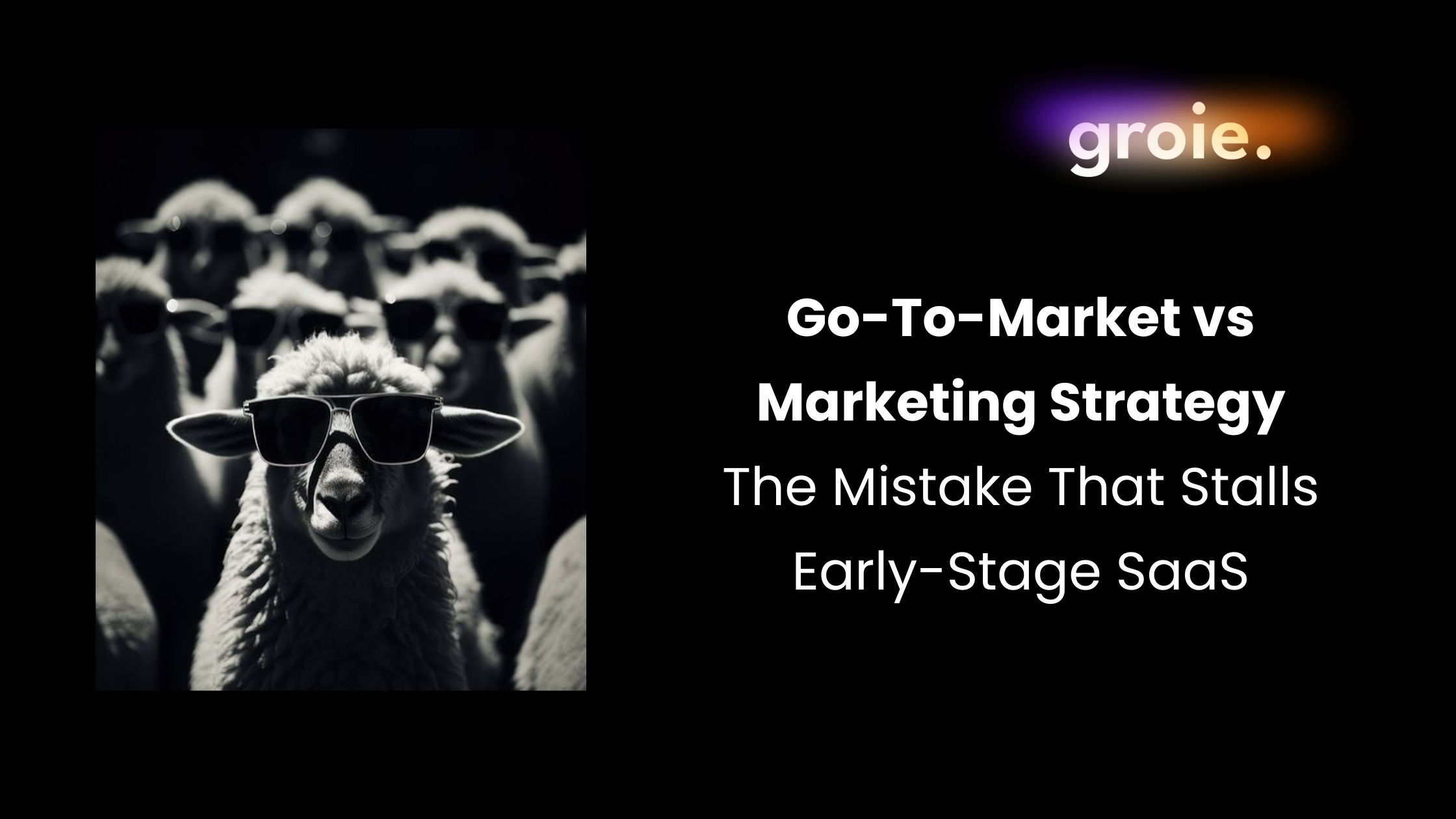
Go-To-Market vs Marketing Strategy: The Mistake That Stalls Early-Stage SaaS
.png)
You are a growing SaaS companies, ranging ARR between $250K-$500K and your next target is $1M. But the way you scaled to $500K (which was quick and fast) suddenly seems plateaued.
The conversion rate has dropped since last quarters and this is coming to you as a warning sign.
.png)
At this stage, most SaaS teams:
This is exactly why messaging, positioning, and GTM alignment become your biggest lever to improve conversion rates, not just more traffic or more outbound.
Most SaaS teams between $250K and $1M ARR don’t have a product problem.
They have a go-to-market problem they haven’t spotted yet.
At this stage, the product works. You’ve got paying customers. A few channels are running. Some outbound efforts are in motion. There’s content going out. Maybe you’ve even hired a small team to manage growth.
This indicates that most SaaS teams between $250K and $1M ARR don’t have a product problem. They have a go-to-market problem they haven’t spotted yet. At this stage, the product works. You’ve got paying customers. A few channels are running. Some outbound efforts are in motion. There’s content going out. Maybe you’ve even hired a small team to manage growth.
But the results are uneven. There isn't one GTM channel that is consistently giving you exceptional results (which at this point you should've established by now). But there are a few performing (above average/below average) as month-on-month basis.
That’s when you know your early-stage GTM system is no longer enough. You’ve outgrown it. And now, it’s starting to slow you down.
Most SaaS founders build traction through founder-led marketing, network referrals, cold outreach, and some basic product marketing. It works well early on. But those same tactics when stretched beyond their shelf life - become bottlenecks.
You’re still relying on motions that were built for speed and survival, not scale. Your funnel isn’t converting consistently, messaging is still the same and instead of building a marketing engine that should've evolved as you grow, has hit a wall.
If you're stuck somewhere between $250K and $1M ARR, it's time to move from founder-led execution to a structured go-to-market system designed for scaling.
This is the transition that separates growing SaaS companies from the ones that actually break through.
What worked at $50K ARR won’t work now. Your product has more features. It solves more complex problems. Your buyer persona has changed, but your messaging hasn’t.
This is where SaaS positioning strategy for scaling startups becomes critical. You're attracting the wrong segments, repelling high-value ones, and confusing the middle.
You’ve passed PMF, but your messaging didn’t grow with you. Time to fix it.
Start with: Working on "how to fix SaaS positioning after PMF". It’s not about rewriting headlines but retelling your story to match where your product is now.
You’ll also need to solve for deeper messaging challenges for SaaS companies; like positioning across multiple segments, ACVs, and sales motions.
You’ve added tools, built sequences, maybe even hired SDRs. But the reply rates are weak, meetings feel cold, and deals don’t convert.
The problem isn’t the motion but with the narrative but a sign that your SaaS outbound is not working. Fix it by understanding the difference between GTM messaging vs product messaging SaaS.Your outbound isn’t just a numbers game. It’s a clarity game. You’re hitting inboxes, but not with context, urgency, or relevance.
Traffic is fine. SEO is doing its job but the conversions are random, demo quality is inconsistent. This is where SaaS website not converting becomes a silent killer.
Why? Because your homepage is vague. You’re speaking to five ICPs with one message. The CTA asks for a demo before showing clarity.
No, you don’t need a full redesign. But you do need to fix your website messaging for SaaS buyers. Focus on clarity by segment. Then map user journeys that push intent, not just pageviews.
Start here: How to improve SaaS demo conversion rate with funnel-aligned content and better qualification.
You’ve got the team. But each GTM touchpoint says something different. Your outbound talks about one value prop. Your ads talk about another. Your demo says something else.
This is what breaks momentum: messaging drift and a calling to have sales enablement in motion.
You need better marketing and sales alignment SaaS. Not just in meetings; but across landing pages, emails, decks, and the demo script. This is why most B2B SaaS GTM motion examples you’ll find online fall flat; they don’t sync narrative across the funnel.
Your next step? Build a clear GTM strategy for growing SaaS companies, where all teams speak from the same playbook.
You’re publishing blogs and visible on LinkedIn. But deals aren’t closing faster. Objections are still the same. Sales enablement is weak. You’ve got content; but it’s disconnected from your funnel.
That’s why SaaS content is not generating pipeline. It’s being made for reach, not revenue.
Shift your strategy. Focus on content strategy for growing SaaS; where every piece warms leads, educates the buyer, or helps close deals.
Start with: how to map content to SaaS sales funnel.
Because if it’s not helping your sales team move deals, it’s not helping at all.
You hired a growth person. A designer. A marketing generalist. And now? You’re still directing everything. This is what happens when you hire individuals but don’t build structure.
Learn how to scale SaaS GTM team without turning into the bottleneck.
What you need isn’t more hands, it’s system-level thinking: messaging docs, repeatable campaign flows, feedback loops, and clear ICP maps. You’re stuck in chaos because you haven’t mapped the full GTM engine.
Even your hire matters: do you need a GTM operator vs head of marketing? Because they are not the same thing.
This is the stage where you need infrastructure and not just effort.
You closed logos across 3–4 verticals and maybe, running outbound for all of them. Perhaps, built multiple homepages and wrote 5 variations of the copy. But is it really working?
This is when SaaS market focus vs experimentation becomes real. If and when the attention gets fragmented and clarity of ICP is questionable, the narrative doesn't go deep enough.
Want results? Pick one and win there.
The smarter play is building a tight SaaS segment expansion strategy, not just chasing every account that’s close to your past customer. Scaling happens when positioning compounds. Not when you chase everyone.
Use focus as a strategy. That’s how to scale into new ICPs without diluting your edge.
This article isn't intended to answer that. It is something that only you can do it but all we know is - this is SOLVABLE.
A lot of founders learn as they go, and, as they scale. They key here is to evolve fast, and ship even faster, ensuring that GTM isn't running on early-stage defaults. Think of this article as your checklist.
If you’re past $250K ARR and starting to feel growth get heavier—this is your checklist.
You need better messaging.
Tighter funnels.
More focused segments.
Content that’s aligned to deals.
And a system that scales without you in every decision.
Start fixing from here.
